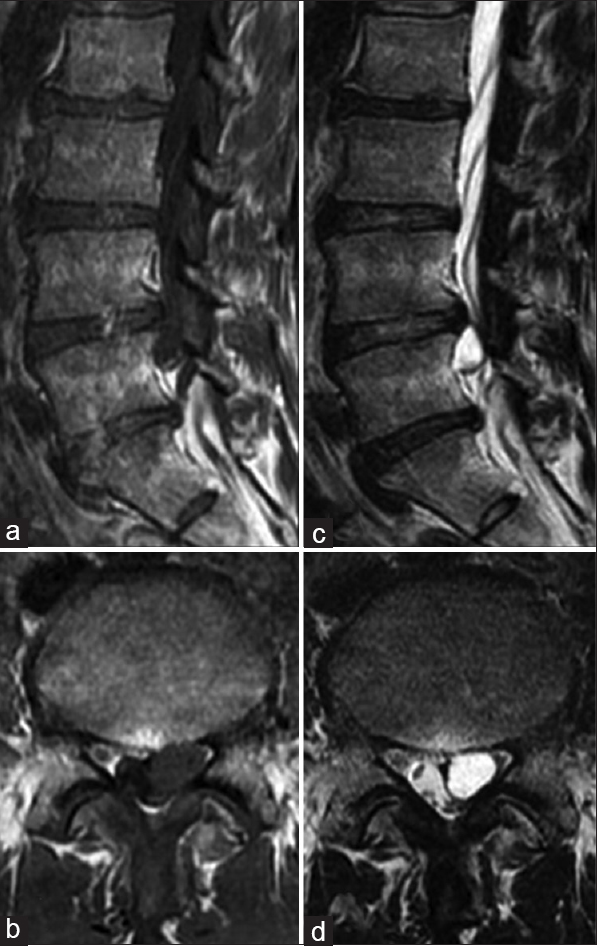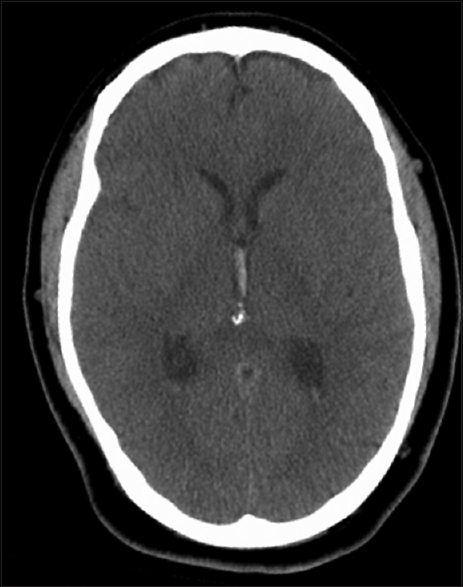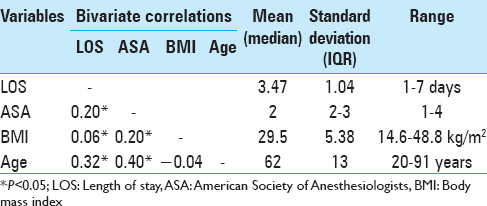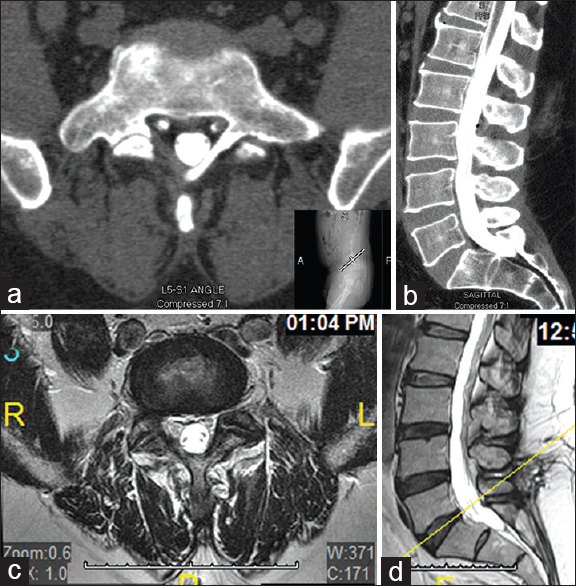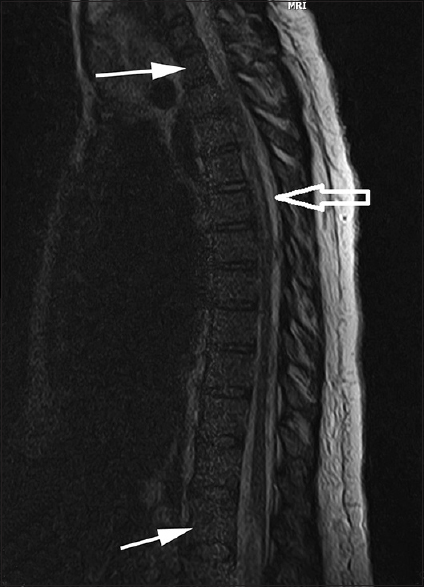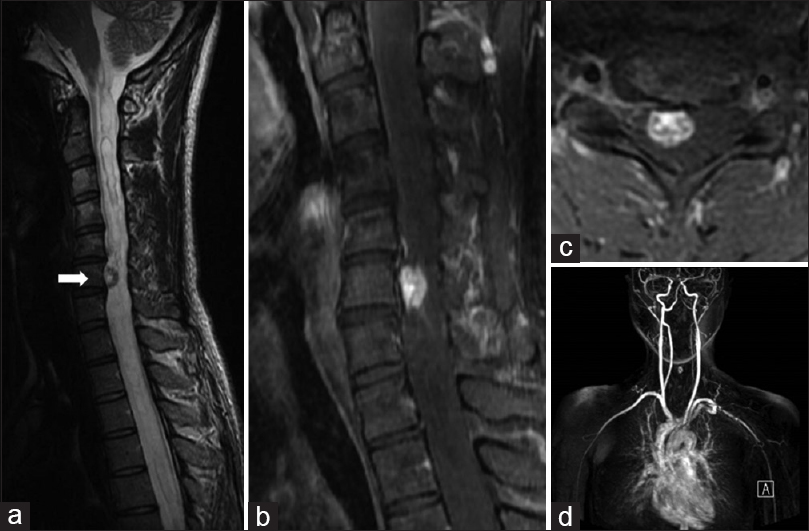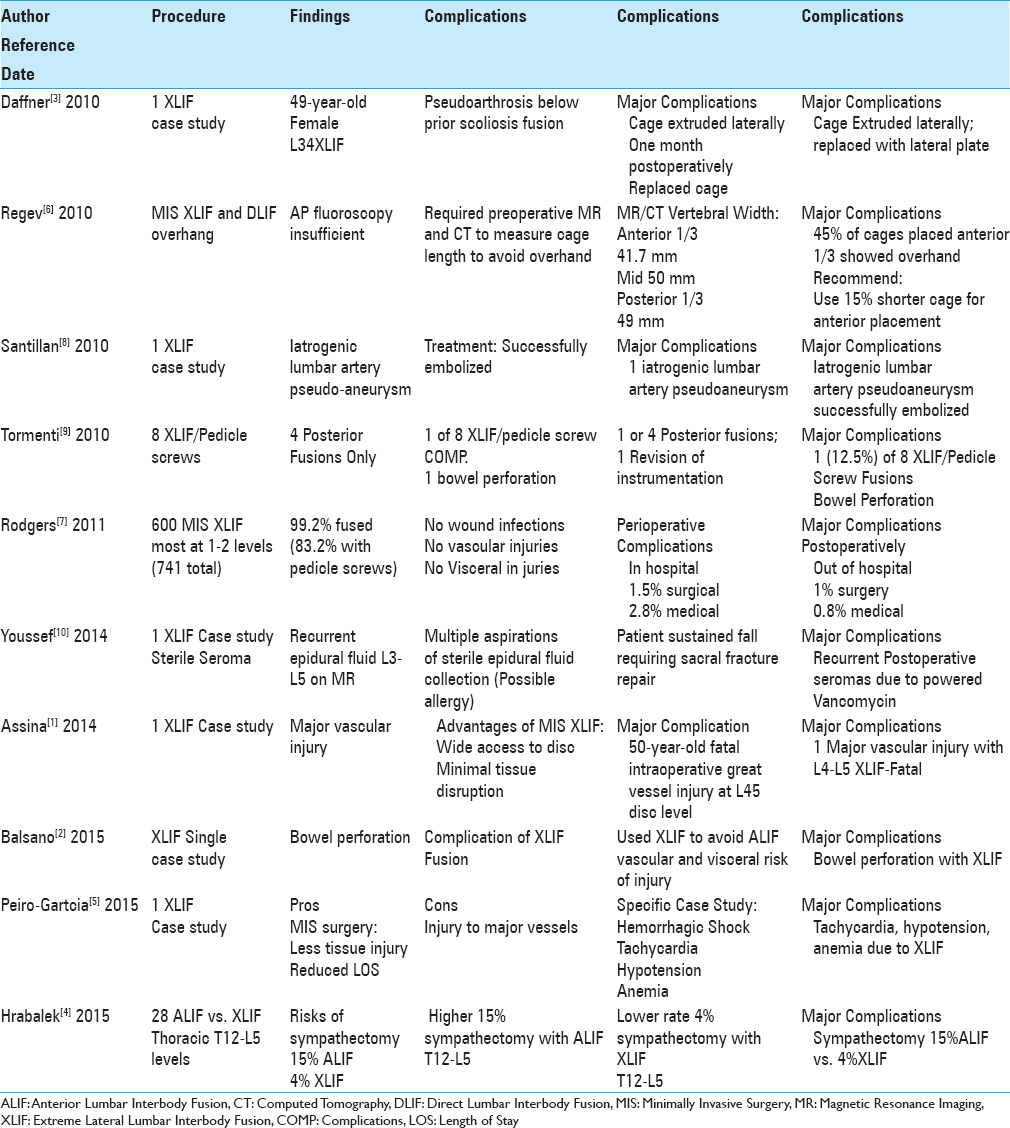Transition of a herniated lumbar disc to lumbar discal cyst: A case report
Date of publication: 22-Sep-2016
Background:Another rare cause of lower back pain with radiculopathy is the discal cyst. It is believed to arise from degeneration of a herniated disc, although many other theories of its origin have been proposed. Here, we report a patient with lower back pain/radiculopathy attributed originally to a herniated lumbar disc, which transformed within 6 months into a discal cyst.
Extreme lateral lumbar interbody fusion: Do the cons outweigh the pros?
Date of publication: 22-Sep-2016
Background:Major factors prompted the development of minimally invasive (MIS) extreme lateral interbody fusion (XLIF; NuVasive Inc., San Diego, CA, USE) for the thoracic/lumbar spine. These include providing interbody stabilization and indirect neural decompression while avoiding major visceral/vessel injury as seen with anterior lumbar interbody fusion (ALIF), and to avert trauma to paraspinal muscles/facet joints found with transforaminal lumbar interbody fusion (TLIF), posterior lumbar interbody fusion (PLIF), and posterior-lateral fusion techniques (PLF). Although anticipated pros of MIS XLIF included reduced blood loss, operative time, and length of stay (LOS), they also included, higher fusion, and lower infection rates. Unanticipated cons, however, included increased morbidity/mortality rates.
Cervical spine surgery performed in ambulatory surgical centers: Are patients being put at increased risk?
Date of publication: 22-Sep-2016
Background:Spine surgeons are being increasingly encouraged to perform cervical operations in outpatient ambulatory surgical centers (ASC). However, some studies/data coming out of these centers are provided by spine surgeons who are part or full owners/shareholders. In Florida, for example, there was a 50% increase in ASC (5349) established between 2000–2007; physicians had a stake (invested) in 83%, and outright owned 43% of ASC. Data regarding “excessive” surgery by ASC surgeon-owners from Idaho followed shortly thereafter.
Effect of spinal cord compression on local vascular blood flow and perfusion capacity by Alshareef M, Krishna V, Ferdous J, Aishareef A, Kindy M, Kolachalama VB, et al.
Date of publication: 22-Sep-2016
Background:Different degrees of blood flow/vascular compromise occur with anterior, posterior, or circumferential spinal cord compression/spinal cord injury (SCI). SCI is also divided into primary and secondary injury. Primary SCI refers to the original neurological damage to tissues, whereas secondary injury reflects interruption of normal blood flow leading to further inflammatory response/other local changes which contribute to additional neurological injury.
Delayed hydrocephalus associated with traumatic atlanto-occipital dislocation: Case report and literature review
Date of publication: 22-Sep-2016
Background:Traumatic atlanto-occipital dislocation (AOD) is a rare but often fatal injury. Consequently, long-term data regarding surviving patients have been limited. In particular, the occurrence of hydrocephalus is not well-documented.
Factors influencing the length of stay in patients with lumbar pedicle screw fixation
Date of publication: 22-Sep-2016
Background:Current health care practices aim for cost reduction to achieve maximal benefit. Because of the increasing number of spinal fusions, this area has become a target for both hospitals and payment organizations. Length of stay (LOS) is one potentially modifiable variable to help reduce overall cost. Attempting to predict the LOS in spinal surgery based on patient factors has not revealed a set of variables that are consistently associated with increased stay.
Spinal neuromodulation as a novel surgical option for failed back surgery syndrome following rhBMP exuberant bony growth in instrumented lumbar fusion: A case report and literature review
Date of publication: 22-Sep-2016
Background:Bone morphogenic protein (BMP) for instrumented lumbar fusion was approved in 2002, and since then has led to an increasing incidence of BMP-related neuropathic pain. These patients are usually resistant to conventional medical therapy and frequently undergo multiple surgical revisions without any pain relief.
Large, spontaneous spinal subdural–epidural hematoma after epidural anesthesia for caesarean section: Conservative management with excellent outcome
Date of publication: 22-Sep-2016
Background:Iatrogenic or spontaneous spinal hematomas are rarely seen and present with multiple symptoms that can be difficult to localize. Most spontaneous spinal hematomas are multifactorial, and the pathophysiology is varied. Here, we present a case of a scattered, multicomponent, combined subdural and epidural spinal hematoma that was managed conservatively.
Successful surgical strategy for a cervical hemangioblastoma: Case report
Date of publication: 22-Sep-2016
Background:Hemangioblastomas are hypervascular lesions and hence their surgical management is challenging. In particular, if complete resection is to be attained, all feeding and draining vessels must be occluded. Although most intramedullary spinal cord tumors are treated utilizing a posterior approach, we describe an anterior surgical strategy for resection of an intramedullary cervical hemangioblastoma.
Non-neurological major complications of extreme lateral and related lumbar interbody fusion techniques
Date of publication: 22-Sep-2016
Background:Complications exclusive of new neurological deficits/injuries that follow extreme lateral interbody fusion (XLIF) and related lateral lumbar interbody techniques should be better recognized to determine the safety of these procedures. Unfortunately, a review of the XLIF literature did not accurately reflect the frequency of these “other complications” as few US surgeons publish such adverse events that may lead to medicolegal suits.


